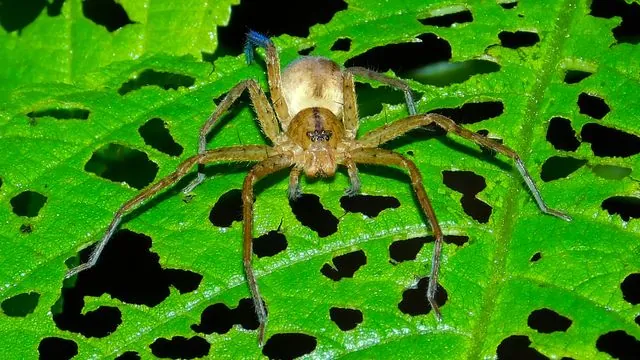
Unraveling the Mysteries of Social Spiders Near Melbourne: Are They Smarter Than We Think?
2025-09-22
Author: Ming
Inside the Arachnid Mind: Social Spiders in Focus
What if spiders could reveal secrets about social behavior and intelligence? Researchers have delved into the brains of social spiders—huntsman and crab spiders—inhabiting areas near Melbourne, using cutting-edge micro CT scanners. Surprisingly, while social and solitary spiders have comparable brain sizes, their wiring tells a much richer story.
Dr. Penna-Gonçalves, a data scientist from Macquarie University, discovered a bustling community of over a hundred spiders inhabiting a single patch of bark—a true testament to social living in a realm dominated by solitary creatures.
The Surprising Discoveries of Social Living
New findings, published in *Integrative Zoology*, challenge conventional wisdom about the social brain hypothesis. Historically, it was believed that social creatures required larger brains to manage complex interactions. However, this research shows that social spiders have developed unique brain structures despite having similar overall brain sizes as their solitary counterparts.
Only 0.1% of the world's 53,000 spider species exhibit sociality, defying the typical image of spiders as aggressive, territorial loners ready to cannibalize one another at the slightest provocation.
Behavioral Differences: Cooperation vs. Isolation
Dr. Penna-Gonçalves posits that the social behavior stems from a 'lazy to launch' phenomenon; baby spiders linger longer in their nest rather than disperse. Those species with extended maternal care exhibit remarkable cooperation, sharing prey rather than turning on each other. Laboratory tests demonstrated that social spider offspring would team up to capture and share a live grasshopper—an impressive feat absent in solitary spiderlings.
Innovative Techniques in Brain Mapping
Peering into the brains of these fascinating creatures involved pioneering techniques that redefined spider neuroscience. Dr. Penna-Gonçalves developed methods for staining spider brains, enabling intricate imaging via micro CT scans—an ambitious process that sometimes took over a hundred days per sample.
Size Doesn’t Tell the Whole Story
Although the research initially posited brain size as a measure of intelligence, it revealed significant differences in internal structures. Social huntsman spiders showcased enlarged regions, such as the arcuate bodies and mushroom bodies—areas linked to memory and cognition, crucial for their sophisticated social maneuvers.
In contrast, social crab spiders displayed enhanced visual processing centers, aligning with their distinct nesting behaviors compared to huntsman spiders.
The Evolutionary Advantage of Sharing
One particularly eye-opening discovery was that social huntsman spiders possess smaller venom glands than solitary ones, highlighting their cooperative survival strategies. By sharing the labor of hunting, they require less venom to subdue their prey, ultimately improving survival efficiency. This intriguingly supports the idea that cooperation can lessen the energy costs associated with venom production.
Complex Societies: A Year-Round Study
Observations over various seasons revealed that their social structures are more nuanced than previously thought, with varying group dynamics throughout the year. The summer months exhibited increased maternal care and larger female gatherings, indicating a thriving community.
Do Spiders Dream? Cutting-Edge Research Continues
Intriguingly, emerging research suggests that some spiders may experience sleep and even dreams. Such revelations challenge existing notions of vertebrate intelligence and highlight the complexity of invertebrate cognition. According to Professor Marie Herberstein, these findings could have far-reaching implications for understanding social intelligence in the animal kingdom.
Ongoing research may leverage innovative techniques, like 'brain soup' to accurately measure neural capacity, potentially reshaping the conversation around intelligence beyond mere brain volume.
Conclusion: Shattering Stereotypes with Science
The exploration into social spiders not only unveils the hidden depths of arachnid capabilities but also encourages a reevaluation of how we define and understand intelligence in the broader spectrum of life on Earth.

 Brasil (PT)
Brasil (PT)
 Canada (EN)
Canada (EN)
 Chile (ES)
Chile (ES)
 Česko (CS)
Česko (CS)
 대한민국 (KO)
대한민국 (KO)
 España (ES)
España (ES)
 France (FR)
France (FR)
 Hong Kong (EN)
Hong Kong (EN)
 Italia (IT)
Italia (IT)
 日本 (JA)
日本 (JA)
 Magyarország (HU)
Magyarország (HU)
 Norge (NO)
Norge (NO)
 Polska (PL)
Polska (PL)
 Schweiz (DE)
Schweiz (DE)
 Singapore (EN)
Singapore (EN)
 Sverige (SV)
Sverige (SV)
 Suomi (FI)
Suomi (FI)
 Türkiye (TR)
Türkiye (TR)
 الإمارات العربية المتحدة (AR)
الإمارات العربية المتحدة (AR)